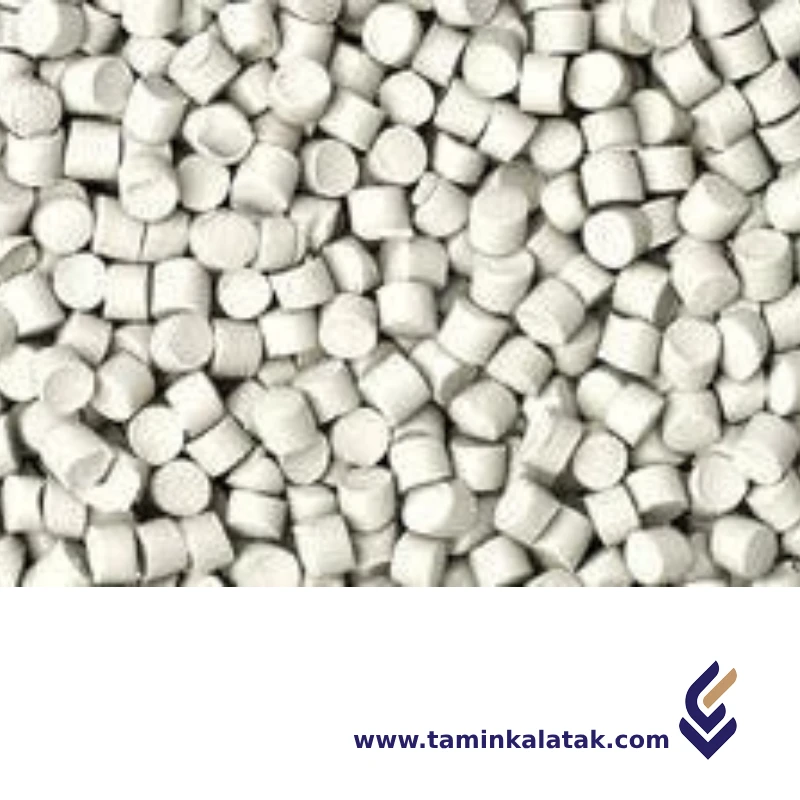Polymers are made up of very large molecules made up of many repeating units called monomers, which ultimately form this long polymer chain
A compound is a polymer blend mixed with additives, fillers, and reinforcements to achieve specific properties for end-use applications. A masterbatch is a concentrated mixture of additives or pigments in a carrier resin, used to enhance plastics without altering their base properties.
Polypropylene Talc Compounds
Polypropylene talc compounds are a blend of polypropylene (PP) resin and talc, a mineral filler used to enhance the mechanical, thermal, and processing properties of the polymer. Talc, primarily composed of magnesium silicate, is incorporated into polypropylene to improve stiffness, dimensional stability, and heat resistance while maintaining a good balance of impact strength and processability.
Structure
Polypropylene talc compounds consist of a polymer matrix made of polypropylene, a semi-crystalline thermoplastic, combined with finely dispersed talc particles. Talc, a naturally occurring magnesium silicate mineral, is integrated into the polymer matrix to enhance mechanical and thermal properties. The structure of these compounds features a heterogeneous phase where talc particles act as a reinforcing filler within the continuous polypropylene phase. The degree of dispersion and interfacial adhesion between the talc and polypropylene significantly influences the overall performance of the material. The crystalline regions of polypropylene provide strength and rigidity, while the amorphous regions contribute to impact resistance and flexibility. The inclusion of talc modifies the crystalline morphology, increasing stiffness, reducing shrinkage, and improving dimensional stability. The overall structure results in a composite material that offers a balance of strength, thermal resistance, and processability, making it suitable for applications that require durability and high performance under mechanical stress.
Properties
Polypropylene talc compounds exhibit a unique combination of mechanical, thermal, and chemical properties that make them suitable for a wide range of applications. The addition of talc significantly enhances stiffness and rigidity, improving the material’s structural integrity and load-bearing capacity. These compounds also offer excellent dimensional stability, reducing shrinkage and warpage, which is crucial for precision-molded components. The presence of talc increases the heat deflection temperature, making the material more resistant to thermal deformation in high-temperature environments. Additionally, polypropylene talc compounds maintain good impact resistance, with the level of toughness depending on the talc content and polypropylene grade. They also demonstrate superior scratch and wear resistance, making them ideal for automotive and household applications. The material retains polypropylene’s inherent chemical resistance to acids, bases, and organic solvents, ensuring durability in harsh environments. Moreover, the addition of talc reduces the coefficient of thermal expansion, minimizing thermal expansion-related distortions. The density of the compound increases with higher talc content, generally ranging from 0.95 to 1.20 g/cm³. Overall, polypropylene talc compounds provide a balance of strength, heat resistance, and processability while maintaining cost-effectiveness for various industrial applications.
Applications of Polypropylene Talc Compounds
- Automotive Industry: Used in dashboards, interior trims, bumpers, door panels, and under-the-hood components for improved stiffness and thermal resistance.
- Appliances & Consumer Goods: Found in washing machine parts, vacuum cleaner housings, kitchenware, and furniture components due to durability and scratch resistance.
- Industrial & Packaging: Utilized in rigid containers, crates, pallets, and technical parts requiring dimensional stability.
- Construction Materials: Applied in pipes, fittings, wall panels, and roofing sheets for strength and thermal stability.
- Electrical & Electronics: Used in enclosures, switchgear housings, and insulation components for mechanical durability and heat resistance.
- Medical & Healthcare: Employed in trays, medical device housings, and equipment casings due to chemical resistance and processability.
Advantages of Polypropylene Talc Compounds
- Increased Stiffness & Rigidity: Talc reinforcement significantly improves mechanical strength.
- Enhanced Dimensional Stability: Reduces shrinkage and warpage in molded parts.
- Higher Heat Deflection Temperature (HDT): Provides better resistance to thermal deformation.
- Improved Scratch & Wear Resistance: Suitable for high-contact surfaces like automotive interiors and appliances.
- Good Chemical Resistance: Maintains durability against acids, bases, and organic solvents.
- Lower Coefficient of Thermal Expansion (CTE): Minimizes expansion and contraction with temperature changes.
- Cost-Effective: Offers a balance of performance and affordability compared to high-performance engineering plastics.
- Better Processability: Allows easy molding, extrusion, and thermoforming with enhanced flow properties.
Disadvantages of Polypropylene Talc Compounds
- Reduced Impact Strength: High talc content can make the material more brittle, especially at low temperatures.
- Increased Density: The addition of talc raises the overall weight compared to pure polypropylene.
- Lower Flexibility: Higher stiffness results in reduced elongation and ductility.
- Limited UV Resistance: Requires UV stabilizers for prolonged outdoor exposure.
- Potential Processing Challenges: High talc loading may affect moldability and increase tool wear during injection molding.
Polypropylene Talc Compounds
| Products | Melt Flow Index (MFI) (g/10 min) | Density (g/mm³) | Process method | Applications | MSDS |
|---|---|---|---|---|---|
| Polypropylene Talc Compounds | 1-25 | 0.90-1.20 | "Injection molding Extrusion Blow molding Thermal forming Compounding and pelletizing" | Automotive Industry Household Appliances and Consumer Goods Industrial and Packaging Construction Materials Electrical and Electronics Medical and Healthcare |







